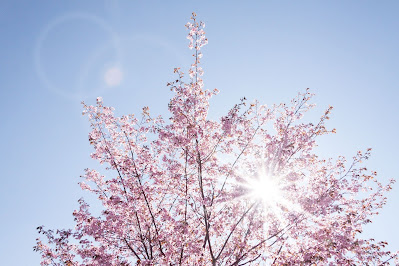Cherry blossoms are on my mind this week. Understandably, as they're blooming beautifully right now in nearly every yard I see. In addition, our COVID-times temporary homeschool geography unit is currently studying the Northeast region of the United States, including Washington D.C. and its stunning cherry blossom trees, and the kids and I created canvas paintings this week of cherry blossoms. On top of all that, we've been filling in some landscaping gaps left by trees hit with disease last year, and a weeping cherry blossom tree is near the top of my latest google searches for what to purchase.
Needless to say, I have cherry blossoms on the brain.
The word for cherry blossoms in Japanese is "sakura", and they carry significance to Japanese history and culture in ways I surely won't understand in a day. But as I've looked into the symbolism and importance of sakura, they've become even more beautiful to me, as I think most of God's creation does when we take time to sit with it, study it, and reflect on it.
"Day after day [the skies] pour forth speech; night after night they reveal knowledge. They have no speech, they use no words; no sound is heard from them. Yet their voice goes out into all the earth, their words to the ends of the world." -Psalm 19:2-4
Sakura are known to be a sign of spring, a symbol of renewal, and a reminder to embrace the delicately fleeting yet beautiful nature of life. They blossom yearly in Japan between April and May, around the same time as the start of the Japanese school year, when everything feels fresh, and young hearts and minds are full of new hope. As in the U.S., the springtime awakening of buds and blossoms brings a sense of renewal; sakura indicate the end of winter and another beginning.
The symbolism of sakura goes beyond that, though. Cherry blossoms are a springtime showstopper, to be sure. Stunning beauties, they can take your breath away when in bloom. Yet their bloom is spectacularly short lived. A cherry blossom tree blooms for merely ten days, before those tiny petals gracefully float and swirl their way down to the ground on the breeze. In Japan, this serves as a reminder of the fragile beauty of life; the ephemeral nature of a moment of joy. Japanese appreciation of sakura is linked to the Buddhist concepts of mortality, calling on viewers of the blossoms to exist in the present moment, because it will be all too fleeting.
This thoughtful natural reminder of life, death, renewal, and hope, is so cherished in Japan as to be the national flower, and the inspiration for countless works of art by Japanese poets, painters, filmmakers, and musicians.
"Gazing at them / I've grown so very close / to these blossoms; / to part with them when they fall / seems bitter indeed!" - Saigyo (Japanese poet & Buddhist monk)
As I see the cherry blossoms in my town in the United States this year, I hope I take a breath longer to appreciate their delicate beauty. To observe them a little more carefully, a little more intentionally. To reflect for just a moment longer on what it is to love something so beautiful, for such a short time, and to see in that reflection a glimmer of perspective on my own life in this beautiful world. To see, in a flower, a fresh start, a new hope, a renewal of spirit ... and at the same time an urgency to be present, to be mindful, because the beauty of spring - for whatever you wish to take spring to mean - will one day fade, and float away into the breeze.
"Cherry blossoms fall / when the time is right / I too will fall / when it is time to go" - Roy Isami Ebata, 1919-1990




No comments:
Post a Comment
Using the internet does not excuse intolerance, and anonymity does not negate civility. Thanks for being thoughtful! :-)